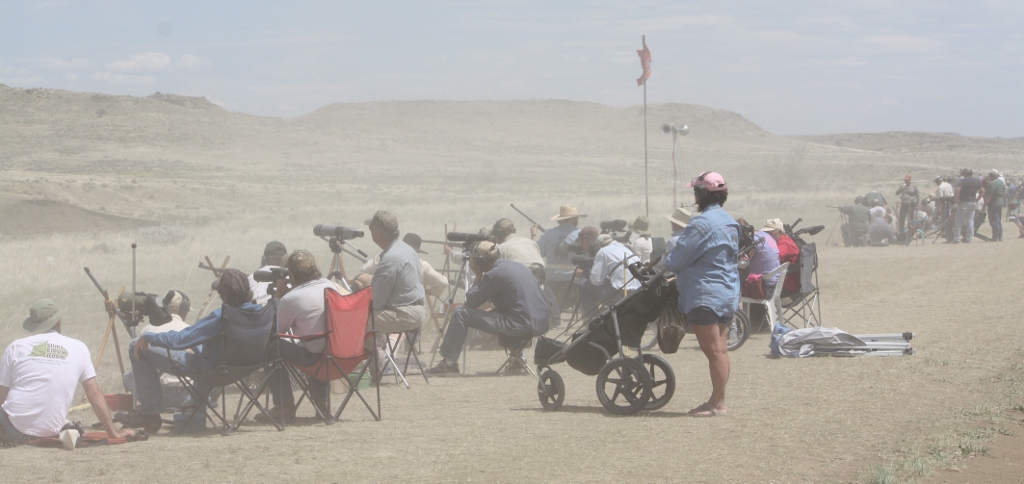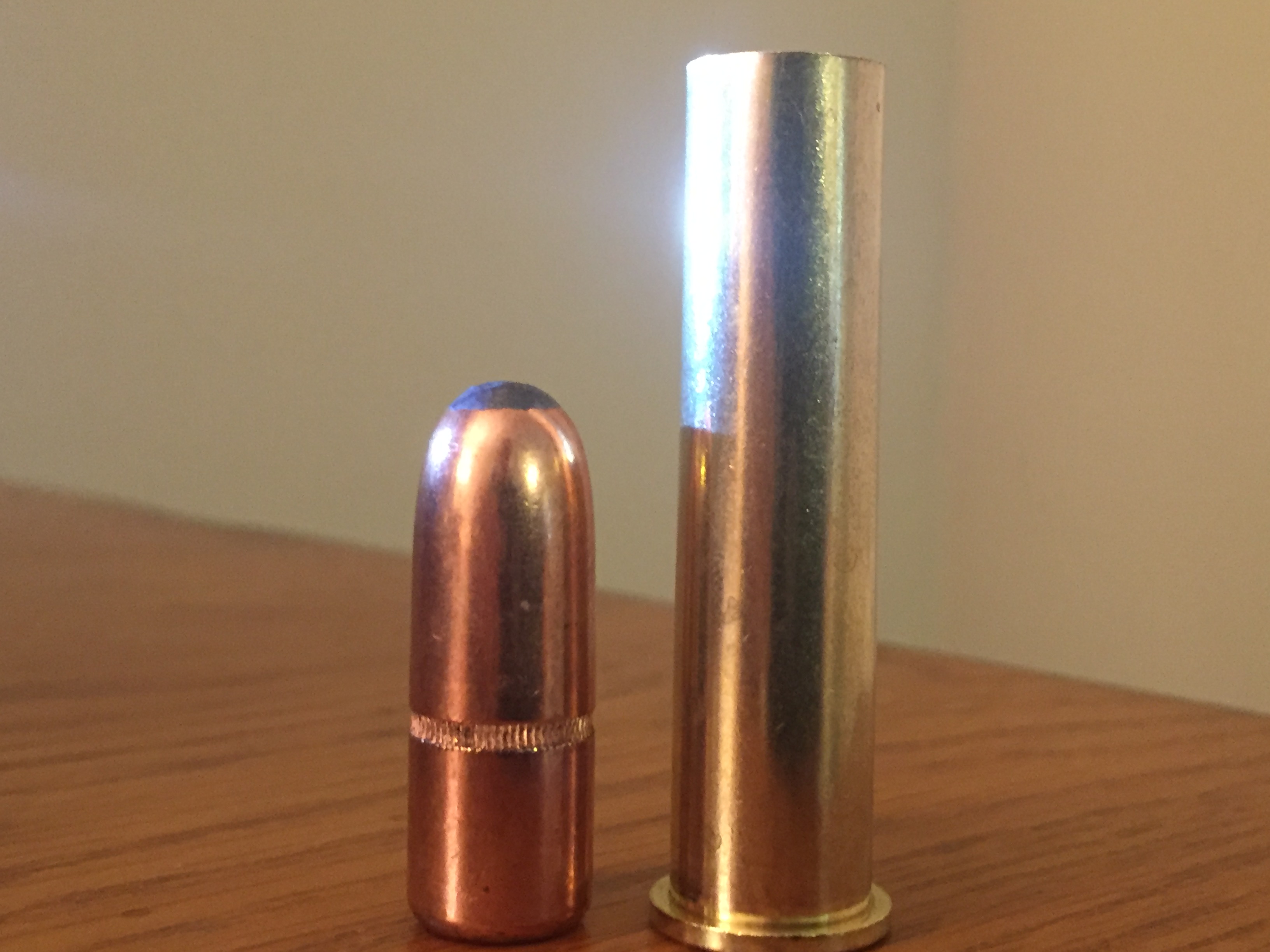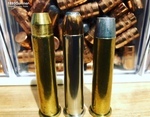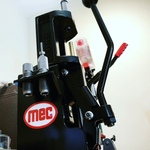 |
BULLET POINTS |
 |
BULLET POINTS |

|
The 45-70 Government Cartridge by Scott Crawford - May 7, 2020 
Born in 1873, 147 years ago the 45-70 was completely identified as the .45-70-405, but was also referred to as the ".45 Government" cartridge in commercial catalogs. The nomenclature of the time was based on three properties of the cartridge:
The minimum acceptable accuracy of the .45-70 from the 1873 Springfield was approximately 4 inches at 100 yards, however, the heavy, slow-moving bullet had a "rainbow" trajectory, the bullet dropping multiple yards at ranges greater than a few hundred yards. A skilled shooter, firing at known range, could consistently hit targets that were 6 × 6 feet at 600 yards—the Army standard target. It was a skill valuable mainly in mass or volley fire, since accurate aimed fire on a man-sized target was effective only to about 200–300 yards. 
45-70 x 535-grain Gas-Checked, Hard Cast Bullets After the Sandy Hook tests of 1879, a new variation of the .45-70 cartridge was produced: the .45-70-500, which fired a heavier, 500-grain bullet. The heavier bullet produced significantly superior ballistics, and could reach ranges of 3,350 yards, which were beyond the maximum range of the .45-70-405. While the effective range of the .45-70 on individual targets was limited to about 1,000 yards with either load, the heavier bullet produced lethal injuries at 3,500 yards. At those ranges, the bullets struck point-first at a roughly 30 degree angle, penetrating three 1-inch thick oak boards, and then travelled to a depth of eight inches into the sand of the beach. It was hoped the longer range of the .45-70-500 would allow effective volley fire at ranges beyond those normally expected of infantry fire. 
Matthew Quigley Buffalo Rifle Match Today the 45-70 is shot in many long range competitions such as the Matthew Quigley Buffalo Rifle Match in Forsyth, Montana. Where multitude of cartridges compete at distance and has been doing so for thirty years. The modern 45-70 loaded from mild to wild can be a very cost competitive round especially if you cast your own boolits and load your own rounds. Even if you don’t cast, there are so many bullet options out there with this wildly popular round that will keep your costs down with light loads for plinking, hunting & just plain enjoying the big bore. While the nominal bore diameter was .450 inches, the groove diameter was actually closer to .458 inches. As was standard practice with many early commercially-produced U.S. cartridges, specially-constructed bullets were often "paper patched", or wrapped in a couple of layers of thin paper. This patch served to seal the bore and keep the soft lead bullet from coming in contact with the bore, preventing leading. Like the cloth or paper patches used in muzzle loading firearms, the paper patch fell off soon after the bullet left the bore. Paper-patched bullets were made of soft lead, .450 inches in diameter. When wrapped in two layers of thin cotton paper, this produced a final size of .458 inches to match the bore. Paper patched bullets are still available, and some black-powder shooters still "roll their own" paper-patched bullets for hunting and competitive shooting. Arsenal loadings for the .45-70-405 and .45-70-500 government cartridges generally used groove diameter grease groove bullets of .458 inches diameter. 
Starline Brass & Hornady 500-grain Interlock As is usual with military ammunition, the .45-70 was an immediate hit among sportsmen, and the .45-70 has survived to the present day. Today, the traditional 405-grain load is considered adequate for any North American big game within its range limitations, including the great bears, and it does not destroy edible meat on smaller animals such as deer due to the bullet's low velocity. It is very good for big game hunting in brush or heavy timber where the range is usually short. The .45-70, when loaded with the proper bullets at appropriate velocities, has been used to hunt the African "big-six”. The .45-70 has been loaded and used to hunt everything from birds to elephants] and the cartridge is still undergoing new development work. 
Matthew Quigley The .45-70 is a long-range caliber, and accurate use requires knowledge of windage and elevation by minute of angle and a sense for estimating distance in these calculations. The .45-70 retains great popularity among American hunters, and is still offered by several commercial ammunition manufacturers. Even when loaded with modern smokeless powders, pressures are usually kept low for safety in antique rifles and their replicas. Various modern sporting rifles are chambered for the .45-70, and some of these benefit from judicious hand loading of homemade ammunition with markedly higher pressure and ballistic performance. Others, which reproduce the original designs still take the original load, but are not strong enough for anything with higher pressures. In a rifle such as the Siamese Mauser (commonly converted to fire .45-70 due to it being the only Mauser 98 derivative designed to feed rimmed cartridges, and the limited availability of ammunition for its original 8×50mmR chambering) or a Ruger No. 1 Single Shot rifle, it can be hand loaded to deliver good performance even on big African game. The .45-70 has also been used in double-rifles since the development of the Colt 1878 rifle and the more modern replicas, like the Kodiak Mark IV. 
Assortment of different 45-70 Hand Loads In addition to its traditional use in rifles, Thompson Center Arms has offered a .45-70 barrel in both pistol and rifle lengths for their “Contender” single-shot pistol, one of the most potent calibers offered in the Contender frame. Even the shortest barrel, 14 inches, is capable of producing well over 2,000 ft-lbs of energy, double the power of most 44 Magnum loadings, and a Taylor KO Factor as high as 40 with some loads. Recent .45-70 barrels are available with efficient muzzle brakes or factory porting that significantly reduce muzzle rise and also help attenuate the recoil. The Magnum Research BFR is a heavier gun at approximately 4.5 pounds, helping it to have much more manageable recoil. Only with the recent introduction of ultra-magnum revolver cartridges such as the .500 S&W Magnum have production handguns begun to eclipse the .45-70 Contender in the field of big game capable handguns. The 45-70 is most popular in lever action rifles primarily produced by Marlin Firearms & Henry Rifles although not limited to those two great brands. The caliber that is quickly approaching a 150 year anniversary seems to be kept in high regard by many hundreds of thousands of rifle & pistol shooters who both love the history & the performance of a great U.S. Government cartridge! IN THIS ARTICLE Matthew Quigley Buffalo Rifle Match |
| |
|
|
 |
 |
 |
 |
 |